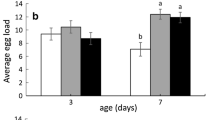Abstract
The costs and benefits of food foraging for the insect parasitoid, Phanerotoma franklini Gahan (Hymenoptera: Braconidae), were examined. Feeding benefited P. franklini by increasing longevity, but did not influence egg maturation. Costs of feeding are represented by the time required to locate and consume food. Field observations of starved wasps revealed that wasps spent approximately 25% of their time grazing on substances on the surface of cranberry foliage. However, our initial laboratory tests to determine the value of these substances were inconclusive. We also examined how grazing behavior integrated with host foraging by comparing the attack rate of fed and unfed wasps held under different host densities. While feeding status did not affect the mean attack rate of wasps, starvation enhanced the probability that a wasp will engage in movement over the host plant foliage. We conclude that feeding benefits P. franklini by increasing longevity, that travel time to food sources is likely to be low, and that the observed food-foraging behavior does not appear to influence host-foraging efficiency.
Similar content being viewed by others
REFERENCES
Averill, A. L. and Sylvia, M. W. (1998). Cranberry Insects of the Northeast. University of Massachusetts. Amherst Extension.
Baggen, R., Gurr, G. M., and Meats, A. (1999). Flowers in tri-trophic systems: mechanisms allowing selective exploitation by insect natural enemies for conservation Biological control. Entomol. Exp. Appl. 91: 155–161.
Bardwell, C. J., and Averill, A. L. (1997). Spiders and their prey in Massachusetts cranberry bogs. J. Arach. 25: 31–41.
Brodeur, J., and Rosenheim, J. A. (2000). Intraguild interactions in aphid parasitoids. Entomol. Exp. Appl. 97: 93–108.
Eijs, I. E. M., Ellers, J., and Van Duinen, G. J. (1998). Feeding strategies in drosophilid parasitoids: The impact of natural food sources on energy reserves in females. Ecol. Entomol. 23: 133
Franklin, H. J. (1950). Cranberry Insects in Massachusetts. Massachusetts Agricultural Experiment Station. Bulletin No. 445.
Godfrey, B. E. S. (1976). Leachates from aerial parts of plants and their relation to plant surface microbial populations. In Dickinson, C. H. and Preece, T. F. (eds.), Microbiology of Aerial Plant Surfaces, Academic Press, New York, pp. 433–440.
Hassell, M. P. (1978). The Dynamics of Arthropod Predator–Prey Systems. Princeton University Press, Princeton, New Jersey.
Heimpel, G. E., and Rosenheim, J. A. (1995). Dynamic host feeding by the parasitoid Aphytis melinus: The balance between current and future reproduction. J. Anim. Ecol. 64: 153–167.
Hendrichs, J., Lauzon, C. R., Cooley, S., and Prokopy, R. J. (1993). Contribution of natural food sources to adult longevity and fecundity of Rhagoletis pomonella. Ann. Entomol. Soc. Am. 86: 250–264.
Jervis, M. A., and Copland, M. J. W. (1996). The life cycle. In Jervis, M., and Kidd, N. (eds.), Insect Natural Enemies: Practical Approaches to Their Study and Evaluation, Chapman & Hall, New York, pp. 63–157.
Jervis, M. A., and Kidd, N. A. C. (1996). Phytophagy. In Jervis, M., and Kidd, N. (eds.), Insect Natural Enemies: Practical Approaches to Their Study and Evaluation, Chapman & Hall, New York, pp. 375–394.
Jervis, M. A., Kidd, N. A. C., Fitton, M. G., Huddleston, T., and Dawah, H. A. (1993). Flower visiting by hymenopteran parasitoids. J. Nat. Hist. 27: 67–105.
Jervis, M. A., Heimpel, G. E., Ferns, P. N., Harvey, J. A., and Kidd, N. A. (2001). Life-history strategies of parasitoid wasps: a comparative analysis of “ovigeny. ” J. Anim. Ecol. 70: 442–458.
Leatemia, J. A., Laing, J. E., and Corrigan, J. E. (1995). Effects of adult nutrition on longevity, fecundity, and offspring sex ratio of Trichogramma minutum. Can. Entomol. 127: 245–254.
Lewis, W. J., and Takasu, K. (1990). Use of learned odors by a parasitic wasp in accordance with host and food needs. Nature 348: 635–636.
Lewis, W. J., Oscar Stapel, J., Cortesion, A. M., and Takasu K. (1998). Understanding how parasitoids balance food and host needs: Importance to biological control. Biol. Contr. 11: 175–183.
Mercier, J., and Lindow, S. E. (2000). Role of leaf surface sugars in colonization of plants by bacterial epiphytes. Appl. Environ. Microbiol. 66: 369–374.
Muesbeck, C. F.W., Krombein, K.V., and Townes, H.K. (1951). Hymenoptera of America North of Mexico. USDA Agric. Monograph. Washington, DC.
Olson, D. M., Fadamiro, H., Lundgren, J.G., and Heimpel, G. E. (2000). Effects of sugar feeding on carbohydrate and lipid metabolism in a parasitoid wasp. Physiol. Entomol. 25: 17–26.
Ramadan, M. M., Wong, T. T. Y., and Beardsley, J. W. (1989). Survivorship, potential, and realized fecundity of Biosteres tryoni, a larval parasitoid of Ceratitis capitata. Entomophaga 34: 291–297.
Schlinger, E. I., and Hall, J. C. (1960). The biology, behavior, and morphology of Praon palitans, an internal parasite of the spotted alfalfa aphid, Therioaphis maculata. Ann. Entomol. Soc. Am. 53: 144–160.
Sears, J. R., Dunn, J., and Harrison, B. (1996). An Illustrated Guide to the Weeds of Cranberry Bogs in Southeastern New England, University of Massachusetts, Dartmouth Publication Series.
Sirot, E., and Bernstein, C. (1996). Time sharing between host searching and food searching in parasitoids: state-dependent optimal strategies. Behav. Ecol. 7: 189–194.
Sisterson, M. S. (2001). Aspects of the Behavior, Ecology, and Evolution of a BraconidParasitoid, University of Massachusetts PhD dissertation. Amherst, Massachusetts.
Takasu, K., and Lewis, W. J. (1993). Host-and food-foraging of the parasitoid Microplitis croceipes: learning and physiological state effects. Biol. Contr. 3: 70–74.
Takasu, K., and Lewis, W. J. (1995). Importance of adult food sources to host searching of the larval parasitoid Microplitis croceipes. Biol. Contr. 5: 25–30.
Tukey, H. B. (1971). Leaching of substances from plants. In Preece, T. F., and Dickinson, C. H. (eds.), Ecology of Leaf Surface Micro-organisms, Academic Press, New York, pp. 67–80.
Wackers, F. L. (1999). Gustatory response by the hymenopteran parasitoid Cotesia Glomerata to a range of nectar and honeydew sugars. J. Chem. Ecol. 25: 2863–2877.
Author information
Authors and Affiliations
Corresponding author
Rights and permissions
About this article
Cite this article
Sisterson, M.S., Averill, A.L. Costs and Benefits of Food Foraging for a Braconid Parasitoid. Journal of Insect Behavior 15, 571–588 (2002). https://doi.org/10.1023/A:1016389402543
Issue Date:
DOI: https://doi.org/10.1023/A:1016389402543




